基于无人机的高光谱成像和机器学习的油菜籽根茎早期检测
IF 5.5
1区 农林科学
Q1 AGRONOMY
引用次数: 0
摘要
在加拿大油菜上,棒根菌(Plasmodiophora brassicae)正在迅速蔓延。这种疾病通常首先出现在小块区域,如果不及时发现和治疗,就会蔓延到整个区域。早期发现是具有挑战性的,因为地上的症状在作物开始开花后才出现,这时很难进行探测。梅花会干扰植物的水分吸收,延迟开花时间,这可能会导致光谱反射率的变化,这可以用高光谱相机检测到。目的是确定无人机安装的高光谱相机是否可以用来识别空中的梅花。使用配备高光谱相机的遥控飞机系统,在2021年至2023年期间,对艾伯塔省和萨斯喀彻温省的23个研究和商业油菜田进行了成像。阿尔伯塔省的一个研究地点提供了一种理想的受感染和未受感染的油菜组合,用于训练预测分类模型。使用机器学习(ML)和详细的绘图进行模型开发产生了最好的结果。随机梯度增强(SGB)始终优于其他ML分类算法测试。随后使用31个光谱波段的SGB模型来评估来自可以确定与现场采样进行比较的地点的21张图像。这些比较在野外水平上产生了100 %的club broot检测一致性和>; 90 %的单个补丁一致性。近红外波段758 ~ 764 nm最为重要,尤其是760和764 nm。无人机和高光谱技术的使用有望改善对棍棒病的检测,因此种植者可以选择适当的作物轮作或治疗受感染的斑块。本文章由计算机程序翻译,如有差异,请以英文原文为准。
Early detection of clubroot in canola using drone-based hyperspectral imaging and machine learning
Clubroot (Plasmodiophora brassicae) is spreading rapidly on canola (Brassica napus) in Canada. The disease often occurs first in small patches and then spreads across the field if not recognized and treated. Early detection is challenging because above-ground symptoms develop after the crop starts to flower, when scouting is difficult. Clubroot interferes with water uptake and delays flowering, which may result in changes in spectral reflectance that could be detected using a hyperspectral camera. The objective was to determine if a drone-mounted hyperspectral camera could be used to identify patches of clubroot from the air. Twenty-three research and commercial canola fields were imaged in Alberta and Saskatchewan during flowering from 2021 to 2023, using a remotely piloted aircraft system outfitted with a hyperspectral camera. One research site in Alberta offered an ideal mix of infected and non-infected canola for training a predictive classification model. Model development using machine learning (ML) and detailed plot mapping yielded the best results. Stochastic Gradient Boosting (SGB) consistently outperformed other ML classification algorithms tested. A 31-spectral band SGB model was subsequently used to assess 21 images from locations where comparisons with field sampling could be made with certainty. These comparisons yielded 100 % agreement in clubroot detection at the field level and > 90 % agreement for individual patches. Near infrared bands 758–764 nm were most important, especially 760 and 764 nm. Use of drones and hyperspectral technology offers promise for improved detection of clubroot so growers could choose appropriate crop rotations or treat infested patches.
求助全文
通过发布文献求助,成功后即可免费获取论文全文。
去求助
来源期刊

European Journal of Agronomy
农林科学-农艺学
CiteScore
8.30
自引率
7.70%
发文量
187
审稿时长
4.5 months
期刊介绍:
The European Journal of Agronomy, the official journal of the European Society for Agronomy, publishes original research papers reporting experimental and theoretical contributions to field-based agronomy and crop science. The journal will consider research at the field level for agricultural, horticultural and tree crops, that uses comprehensive and explanatory approaches. The EJA covers the following topics:
crop physiology
crop production and management including irrigation, fertilization and soil management
agroclimatology and modelling
plant-soil relationships
crop quality and post-harvest physiology
farming and cropping systems
agroecosystems and the environment
crop-weed interactions and management
organic farming
horticultural crops
papers from the European Society for Agronomy bi-annual meetings
In determining the suitability of submitted articles for publication, particular scrutiny is placed on the degree of novelty and significance of the research and the extent to which it adds to existing knowledge in agronomy.
 求助内容:
求助内容: 应助结果提醒方式:
应助结果提醒方式:


